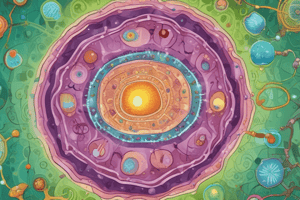Podcast
Questions and Answers
What is the main difference between prokaryotic and eukaryotic cells?
What is the main difference between prokaryotic and eukaryotic cells?
- Prokaryotic cells have a nucleus and eukaryotic cells do not.
- Eukaryotic cells have a nucleus and membranous organelles, while prokaryotic cells do not. (correct)
- Prokaryotic cells have membranous organelles and eukaryotic cells do not.
- Eukaryotic cells have ribosomes and prokaryotic cells do not.
What is the function of the cytoplasm in a living organism?
What is the function of the cytoplasm in a living organism?
- To perform all vital events and functions (correct)
- To synthesize proteins
- To store genetic material
- To protect the cell from external factors
What is the characteristic of the DNA in prokaryotic cells?
What is the characteristic of the DNA in prokaryotic cells?
- It is located in the nucleus
- It is synthesized in the mitochondria
- It is scattered within the cytoplasm (correct)
- It is organized into chromosomes
What type of cells do animals, plants, fungi, and protists belong to?
What type of cells do animals, plants, fungi, and protists belong to?
What is the function of the cell nucleus in eukaryotic cells?
What is the function of the cell nucleus in eukaryotic cells?
What is the characteristic of the cell membrane in prokaryotic cells?
What is the characteristic of the cell membrane in prokaryotic cells?
How do eukaryotic cells divide?
How do eukaryotic cells divide?
What is the characteristic of ribosomes in prokaryotic cells?
What is the characteristic of ribosomes in prokaryotic cells?
Study Notes
Cell Types
- Prokaryotic cells lack a nucleus and membranous organelles, such as mitochondria, and have genetic material (DNA) scattered within the cytoplasm.
- These cells perform vital functions in the cytoplasm and cellular membrane and have ribosomes.
- Examples of prokaryotic cells include bacteria and blue-green algae.
Eukaryotic Cells
- Eukaryotic cells have membranous organelles, a real nucleus, and nuclear material is not scattered within the cytoplasm.
- These cells are more highly developed than prokaryotic cells and include cells of animals, plants, fungi, and protists.
- Eukaryotic cells have organelles in their cytoplasm, chromosomes (DNA and proteins) in the cell nucleus, and divide by mitosis.
Cytoplasm
- Cytoplasm is a semifluid matrix that fills the space between the cell membrane and the nucleus.
- All vital events occur in the cytoplasm of a living organism, and it generally forms a homogeneous transparent mass.
Mitochondria
- Mitochondria are ellipsoidal or cudgel-shaped organelles with a length of 2-3 μm and a diameter of 0.5 μm.
- They are the energy-generating organelles, where the energy released by breaking the chemical bonds of organic molecules is transformed into ATP.
Studying That Suits You
Use AI to generate personalized quizzes and flashcards to suit your learning preferences.
Description
This quiz covers the characteristics of eukaryotic and prokaryotic cells, including their organelles and nucleus or lack thereof. Understand the differences between these cell types and their features.




